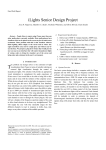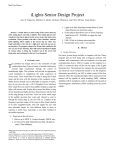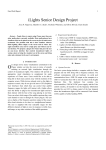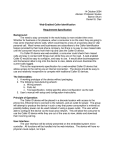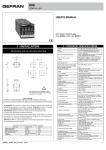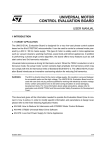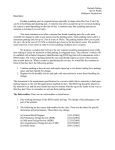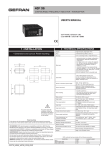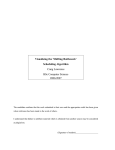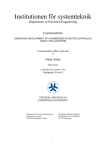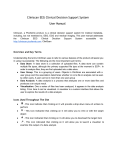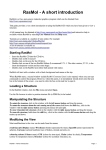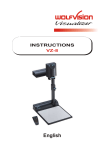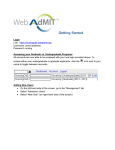Download Draft Report as of 12-3-08
Transcript
Draft Report 1 iLights Design Project Jose D. Figueroa, Matthew C. Ryder, Nicholas Wittemen, and Chris Merola, Team Soules A. Requirement Specifications 1. Deliver up to 500W X 4 output channels, 2000W max. 2. Go from off to fully illuminated and back off again in under 75ms (800bpm). 3. Lights to be fully illuminated within 80ms of audio input (Human sync detection range). 4. iTunes plug-in that allows users to select frequency band between 20 - 20,000Hz as trigger for each channel. 5. USB 1.0 link to Arduino microcontroller. 6. Documented source code + user manual II. DESIGN I. INTRODUCTION problem our design solves is eliminating the constraint of light visualizations from iTunes and actually displaying a light visualization through the control of incandescent lights. This is a problem for people who are visually stimulated. Users would like to be able to bring their songs to life and bring them out of the computer screen. While devices already exist to do this, they do not give the user a GUI (Graphical User Interface) where they can control which audible frequency the lights will interact with. iLights allows users the ability to plug in incandescent light bulbs of various colors and have them interact to the beat of the song currently playing in real time. Users can select which range of the audible spectrum they what a certain channel to react to, and through the plug in the user will see a display of the frequency spectrum output of the song to allow band selection to be done more easily. HE T A. System Overview Our basic design system includes a computer with the iTunes program and our GUI along with a frequency analyzer. From a USB output on the computer, we will have a USB 1.0 cable that will tie into the input of the iLights Hardware Box. The hardware box contains the components needed to take the frequency information provided by our GUI and control the four channels where the incandescent lights will be connected to. Each channel will handle 500W. B. Block Diagram User GUI USB Link Arduino microcontroller Frequency Analyzer Triac Triac Triac Triac iTunes Manuscript received November 20, 2008. This work was supported in part by SDP 2009. Jose D. Figueroa is a senior in Electrical Engineering at UMASS Amherst Matthew C. Ryder is a senior in Electrical Engineering at UMASS Amherst Nicholas Wittemen is a senior in Electrical Engineering at UMASS Amherst Chris Merola is a senior in Electrical Engineering at UMASS Amherst PC C. System Specification iTunes interface External AC lights/power strips iLights Hardware Box Abstract— People listen to music using iTunes more than most media players out there currently. Most media players have visualizers that can be placed on the screen to give the music more excitement. There problem with this is that visualizer software limits lighting effects simply to the screen and no where else. Light controllers exist, but for a high price and with no easy-to-use interface. We propose a plug-in for iTunes that would give the user an easy-to-use interface that will control incandescent lights of various colors to bring the visualizer out of the screen and bring color and excitement to the user’s environment. Draft Report Our software must be able to communicate with iTunes in order to control lights based on the music being played. The software will also allow the user to select frequency ranges that will control each iLights electrical outlet. From data extracted with iTunes we will determine the power contained in a number of user selected frequency bands and use this to set the amplitude of the connected lights. Due to the physical properties of triacs, the fastest we can adjust the power sent to our lights is 120 times per second. This is the rate at which we will retrieve audio spectrum information form iTunes. This data will be updated and packaged to be sent via USB to our hardware continuously. As of this time we are able to extract frequency data from iTunes and display a spectrograph of the audio file being played. To extract frequency data we use the software development kit released by apple for visualization development. Using this we implement a Dynamic Link Library, call a *.dll file, which can access frequency data through iTunes provided variables. iTunes does a FFT (Fast Fourier Transform) of the audio being played and makes available the power contained in 256 samples spaced linearly from 20 Hz to 20kHz. The data is provided is of type Uint8 giving 256 steps of resolution. OpenGL is used to display this data graphically, specifically a package named freeglut. We have chosen this package because is built to be both easy to implement and extremely portable; although we are developing in Windows we would like to be able to port our software to OSX. At this time we are displaying a level bar for each of the 256 available bands. Our code controls the bar height using a log scale in order to compare power in the same way as the human ear. As of now our software is able to communicate with iTunes, extract the frequency spectrum of the audio being played, and display this information graphically. The next step will be to implement a user interface. We will use handlers available in the freeglut package to do this. We have already experimented with input using this package and have determined that it will be able to handle the input our project requires. Serial Port Communication Link The link from the pc to the microcontroller that triggers the switching circuitry is compromised of 2 2 parts: C++ code which translates and transmits the extracted frequency data over the serial port; and an Arduino prototyping board with an Atmega168 that has been programmed to read the serial port data and interpret it into control instructions for triggering the triac circuits. The extracted frequency data will consist of 256 samples of the audible frequency range, and the user will specify 4 different spans of this frequency band they want their 4 lights to react to. The power over each of these frequency bands will provide the output control signal to be written to the serial port. To send these 4 signals simultaneously we will have to store them in an array and write the whole array to the serial port. This writing must occur at the same rate we set the Arduino board to operate at. Currently a baud rate of 19200 has been used consistently in our code. The microcontroller will then read the serial port and take the 4 individual elements of this array and translate the power over each frequency band into the appropriate phase control. Phase control works by turning on a fraction of each half wave; current through the load is proportional to the area under this portion of the sine wave. The Arduino determines when to trigger each triac and turn on this signal to provide phase control. This is done using the Arduino to detect zero-crossings which, since our ac power is mostly constant at 120 Hz, will remain at approximately 1/120 seconds apart. This data will continuously be collected, allowing us to accurately switch on during the desired phase of the pulse, resulting in real-time phase control of the 4 incandescent lights. Jose’s Hardware part The triac switching circuit utilizes a snubberless triac in order to obtain the switching capabilities for the AC power. The snubber circuit is mostly applicable for inductive load situations, which will not be the typical case here where we expect resistive loads. There exist several different circuit configurations from which the most suitable was customized to our needs based on performance and power handling. Matt’s part Text. Draft Report 3 D. Design Alternative We have considered other alternatives in the case that something may not work as originally planned. Reasons we would need alternatives would be if iTunes SDK is inadequate. In this case we have considered the possibility of using alternative media players such as Winamp open-source or VLC media player. The second design alternative would be replacing the triac if it is found not to be the best way for controlling the lights. Silicon-controlled rectifier (SCR) could be another solution for better switching and control of lights. We could also choose Resistive Dimming by rectifying AC to DC and using different lights. However this could limit the amount of power we would be able to switch due to heat emission. III. MDR PROTOTYPE IMPLEMENTATION A. System Overview Please check with your editor on whether to submit your manuscript as hard copy or electronically for review IV. PROJECT MANAGEMENT A. System Overview Our team as split the project up into four main areas: Chris Merola is responsible for designing the easy-touse GUI along with the iTunes plug-in with iTunes SDK to extract frequency information. He is also charged with making the software compatible for both Mac and PC operating systems. Nicholas Wittemen has been progressively developing a serial communications link with C++ and the processing language to make data transfer possible between the iTunes software plug-in and the Arduino microcontroller that will drive the triggers for the triacs in order to control the lights appropriately. Jose D. Figueroa has been assigned to designing the triac circuit which will handle 4 x 500W, 2000W total, and taking all safety precautions when interfacing with a live AC source. He is also the webmaster who is responsible for updating and maintaining Teams Soules’ website. Matthew C. Ryder as been doing research on EMI (Electromagnetic Interference) so that our product not only functions properly within its contained environment but that it also meets all FCC regulations and safely interfaces with normal consumer electronics in a home with out effecting or causing damage to other products. V. SUMMARY AND CONCLUSIONS A. System Overview Please check with your editor on whether to submit your manuscript as hard copy or electronically for review. References B. System Overview Please check with your editor on whether to submit your manuscript as hard copy or electronically for review. * Jose’s book + triac datasheets Nick’s blog sites + Arduino.cc + Freeduino Chris’s open GL book + zero-crossing datasheets



